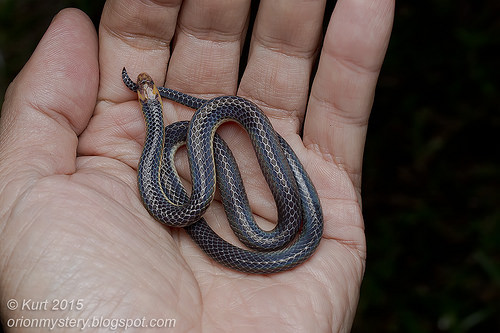Calamaria schlegeli Duméril, Bibron & Duméril 1854
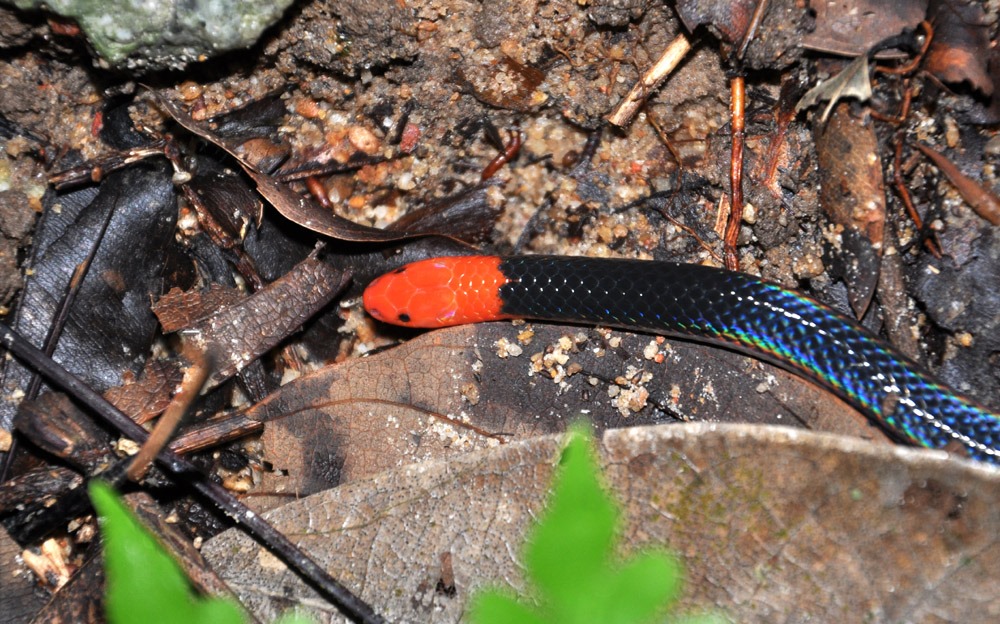
1. NAME & ETYMOLOGY
Binomial name:
Calamaria schlegeli Duméril, Bibron & Duméril 1854 [1]
Table of Contents
Common names:
Pink-headed Reed Snake, White-headed Reed Snake, Red-headed Reed Snake
Subspecies:
Calamaria schlegeli schlegeli Duméril, Bibron & Duméril 1854; Calamaria schlegeli cuvieri Jan 1862
Etymology:
Calamaria schlegeli was named in honor of a German herpetologist, Hermann Schlegel (1804 -1884). It is commonly coined as "reed snake" due to the cylindrical shape of its body [2].
[Back to top]
2. DIAGNOSIS
 |
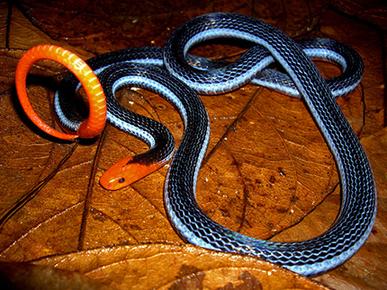 |
| Fig 2: Pink-headed Reed Snake has no colouration on its tail (Photo credit and permission: Nick Baker) |
Fig.3: Malayan Blue Coral Snake has a red tail (Photo credit and permission: Evan S. H. Quah) Note: This is NOT Pink-headed reed snake !!! |
The Pink-headed Reed Snake (Fig. 2), which is not known to be venomous, bears a high resemblance to the venomous Malayan Blue Coral Snake (Calliophis bivirgatus) (Fig. 3). Both species generally have a bright pink/red head and a dark-coloured dorsum [3]. The small-sized Pink-headed Reed Snake (about 45 cm) is much shorter than the medium-sized Malayan Blue Coral Snake (about 1.85 m) [4], but it can get confusing when encountered with juveniles. Their high resemblance, coupled with similar habitat range, makes it easy to confuse the two species for each other.
Look out for the red tail and bright blue stripes on sides of the belly. The Pink-headed Reed Snake (Fig. 2) does NOT have these two features, they belong to the Malayan Blue Coral Snake (Fig. 3) [5].
[Back to top]
3. DESCRIPTION
Original description (in French):
Duméril, A.M.C., G. Bibron & A.H.A. Duméril, 1854. Erpétologie générale ou Histoire Naturelle complète des Reptiles. Vol. 7 (partie 1). Paris, xvi + 780 S. Get paper here.
Fig. 4: Pink-headed Reed Snake in palm. (Photo credit and permission: Kurt)
The Pink-headed Reed Snake is a small snake (Fig. 4) that can take relatively variable forms [6] and its most noticeable variations are in head and venter coloration (compare Fig. 5 and 6). A detailed description of the adult Pink-headed Reed Snake is in Table 1 below.
Juveniles look similar to the adults, except that black bands are present on the posterior half of the belly [2].
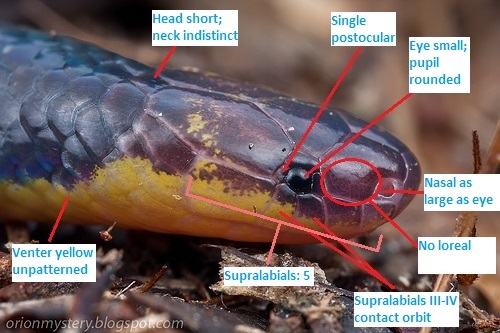 |
 |
| Fig. 5: Pink-headed Reed Snake from Pahang, Malaysia. (Photo credit and permission: Kurt) |
Fig. 6: Pink-headed reed snake from Singapore (Photo credit and permission: Norman Lim) |
Table 1: Description of the adult Pink-headed Reed Snake [4] (Glossary provided)
| Feature |
Description |
| Total Length |
Around 45 cm |
| Head |
Short; indistinct from neck C. s. schlegeli: red or orange C. s. cuvieri : dark brown |
| Eye |
Small; pupil rounded |
| Nasal |
As large as eye |
| Teeth |
Modified maxillary teeth: 9-10 |
| Body |
Slender; cylindrical Smooth dorsum Dorsal colour: - dark brown or black - displays blue-green iridescence under light Venter yellow unpatterned (*can also be grey-white [3]) |
| Tail |
Tapering |
| Scales |
Scale rows MID-BODY: 13 VENTRAL: 130-180 SUBCAUDAL: 19-44; paired Head scales Loreal: Absent Preocular: present or absent Postocular: Single Supralabials: 5; III-IV contact orbit Infralabials: 5; three infralabials contact anterior chin shields Anal scale: Entire |
As a result of its relatively-variable forms, the Pink-headed Reed Snake has numerous synonyms [11]:
Calamaria leucocephala DUMÉRIL, BIBRON & DUMÉRIL 1854: 83
Calamaria agamensis BLEEKER 1859 (fide BOULENGER 1887)
Calamaria nigro-alba GÜNTHER 1864
Calamaria martapurensis EDELING 1865
Calamaria dumerili BLEEKER 1860
Calamaria sinkawangensis BLEEKER 1860
Calamaria schlegeli — JAN 1865
Calamaria iris BOETTGER 1873
Calamaria leucocephala — MERTENS 1930
Calamaria leucocephala — TWEEDIE 1954
Keiometopon booliati TAYLOR 1962
Calamaria schegeli — INGER & MARX 1965: 162
Calamaria schlegelii — MANTHEY & GROSSMANN 1997: 327
Calamaria schlegelii — INGER & VORIS 2001
Calamaria schegeli — HOWARD & GILLESPIE 2007 (in error)
Calamaria cuvieri JAN 1862
Calamaria cuvieri — JAN 1865
Calamaria leucocephala BOULENGER 1894 (non DUMÉRIL & BIBRON), part.
Calamaria agamensis BOULENGER 1894 (non BLEEKER), part.
[Back to top]
4. GLOSSARY
| Term |
Meaning |
| Maxillary |
Belonging to upper jaw |
| Dorsum |
Upper surface |
| Venter |
Bottom surface/Belly |
| Subcaudal |
Underside of tail |
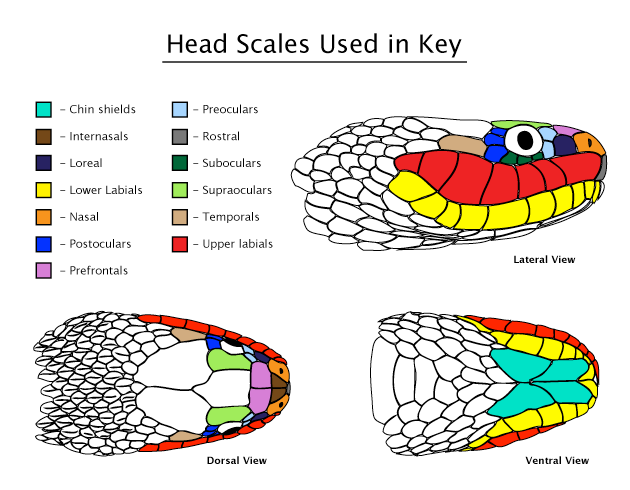 |
[Back to top]
5. VENOMOUS?
The Pink-headed Reed Snake is commonly considered as non-venomous [6][8] and as a member of the genus Calamaria, its bite is believed to be harmless [9]. However, an entry documented in the Singapore Biodiversity Records (Get paper here) reveals that the snake may not be as harmless as popularly believed.
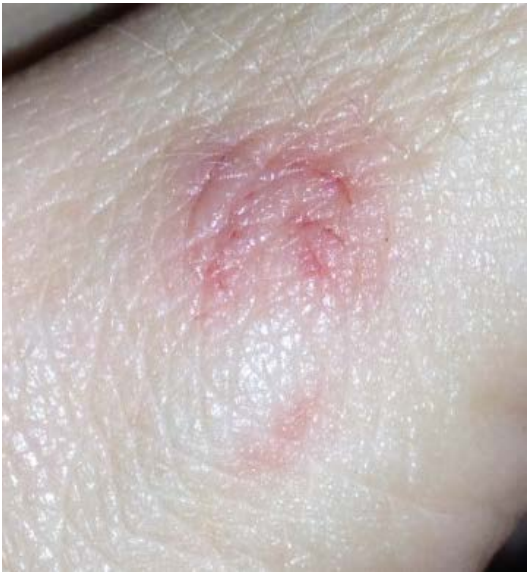 Fig. 8: Bite on index finger by Pink-headed Reed Snake (Photo credit and permission: David Groenewoud) [10] |
After picking up a 40 cm Pink-headed Reed Snake in the Venus Drive forest, David Groenewoud (contributor of entry) was bitten and chewed “in the index finger” (Fig. 8). He then experienced: - numbness in hand and arm, - burning sensation and stinging pain in hand and arm, and - mild stiffening of muscles around the jaws These symptoms subsided in a little less than 2 hours, although “some short periods of numbness in the hand were experienced well into the next afternoon“ [10]. |
The venomousness of the Pink-headed Reed Snake thus requires further investigation. Nonetheless, being small and secretive, the species is more likely to flee than attack, if not under threat. A good guide would be to stay away rather than confront it.
[Back to top]
6. BIOLOGY
Behaviour, Diet and Reproduction
The Pink-headed Reed Snake is nocturnal and semi-fossorial, i.e. partly adapted to burrowing and living underground [2]. Due to such behaviour and its small size, there is a paucity of information regarding the Pink-headed Reed Snake's biology.
It is known that the Pink-headed Reed Snake consumes frogs, small invertebrates (such as slugs [4]) and small insects [3]. In addition, the species is oviparous, i.e. egg-laying, but its clutch size remains unknown [4].
[Back to top]
7. DISTRIBUTION
7.1 Worldwide
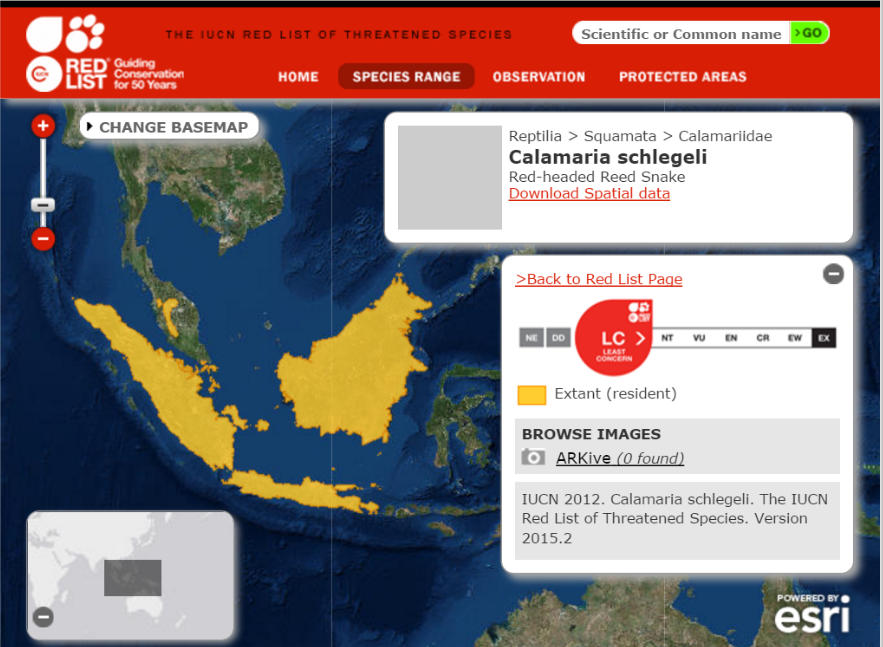 Fig. 9: IUCN distribution of Pink-headed Reed Snake [12] |
According to multiple sources, the Pink-headed Reed Snake can be found in Singapore, Peninsular Malaysia, Sumatra, Borneo, Java, Bali and Thailand [3][4][11]. However, all the aforementioned countries or regions are reflected in the current IUCN distribution map with the exception of Thailand (Fig. 9). As such, its presence in Thailand is uncertain. |
7.2 Singapore
| The Pink-headed Reed Snake is native to Singapore [13]. The Gardens' Bulletin (Singapore) of 1997 lists a total of 26 records for this species. Most of the records are from Lower Pierce (11 records) and Bukit Timah (8 records) [14]. In 2014, a sighting at the Venus Drive forest was documented in the Singapore Biodiversity Records (as mentioned previously) [10]. |
[Back to top]
8. HABITAT
The habitat of the species ranges from forests (both lowland and highland) to agricultural fields, gardens, road-cuts and paths. It is also known to hide under stones, logs, or leaf litter [2].
Video of the Pink-Headed Reed Snake at night in Singapore below (Video permission and credit: Lou Boyer):
[Back to top]
9. CONSERVATION STATUS
The existence of the Pink-headed Reed Snake does not appear to be under threat at present.
Last assessed on 1 September 2011 by IUCN, the species is a Least Concern species due to its widespread presence and lack of major threats. It is also found within protected areas [12].
The species is also not listed in CITES or the Singapore Red Data Book.
10. TYPE INFORMATION [15]
Holotype:
Rijksmuseum van Natuurlijke Historie (RMNH) 10424; 25 cm (RMNH is now known as Naturalis Biodiversity Center)
Type locality:
"ile de Borneo" (Kalimantan, Indonesia)
Syntype:
Museo Civico di Storia Naturale de Milano (C. s. cuvieri)
[Back to top]
11. TAXONAVIGATION [16]
Kingdom Animalia
Phylum Chordata
Class Reptilia
Subclass Lepidosauria
Order Squamata
Suborder Serpentes
Infraorder Alethinophidia
Family Calamariidae
Subfamily Calamariinae
[Back to top]
12. PHYLOGENETIC RELATIONSHIP
12.1 Within genus Calamaria
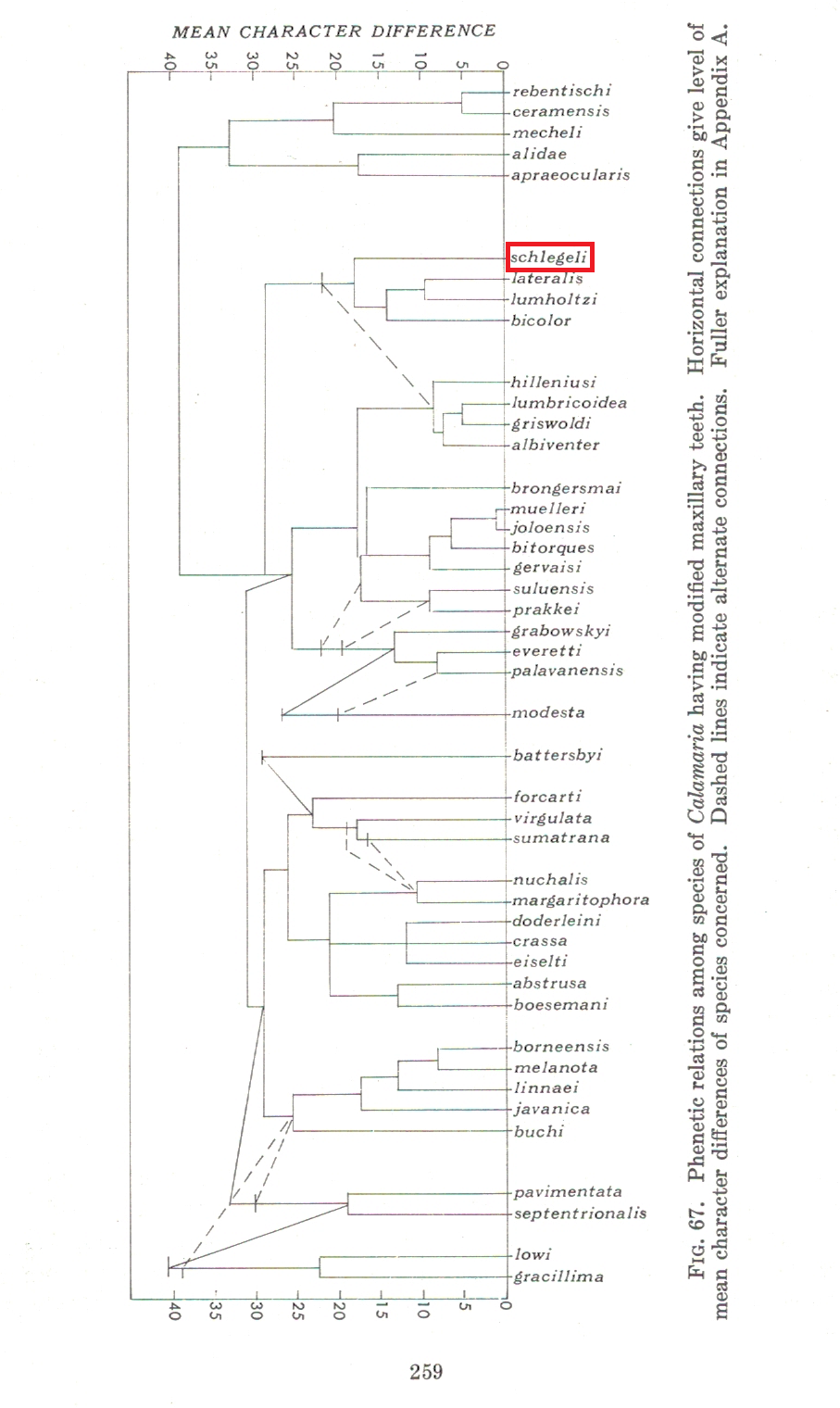 Fig. 10: Dendogram for 44 Calamaria species. [6]. |
Phylogeny within genus Calamaria remains unresolved. A dendogram for the phenetic relationship within genus Calamaria is however available (Fig. 10) [6]. This dendogram was developed by Inger & Marx in 1965 based on mean morphological character differences of 44 Calamaria species which have modified teeth. No phylogenetic relationship is implied by this dendogram because it is purely based on morphological similarities. Despite the increasing popularity of molecular studies, molecular data is still lacking for most Calamaria species, including the Pink-headed Reed Snake. More data is required for the construction of a phylogenetic tree for the genus Calamaria. |
12.2 Within advanced snakes (Serpentes, Caenophidia)
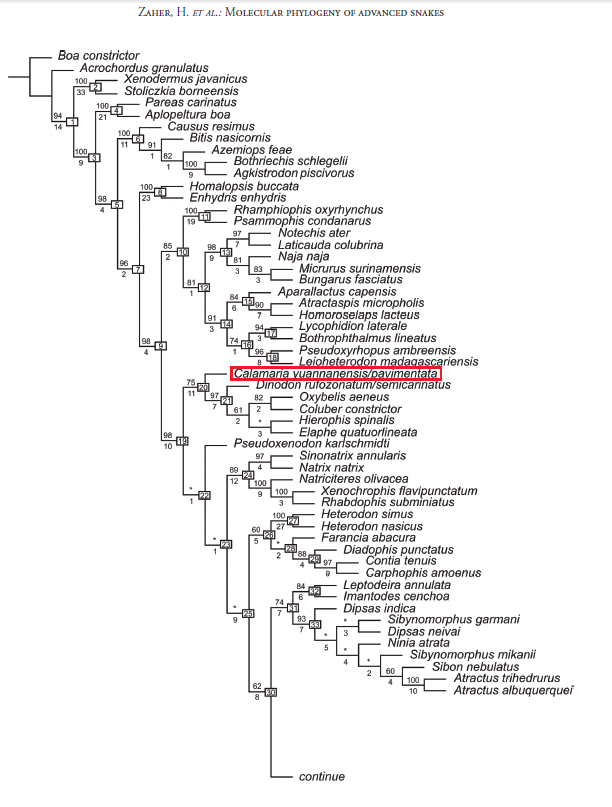 Fig. 11: Part of best phylogenetic tree for caenophidian (advanced) snakes based on 12S, 16S and c-mos [17] |
A recent paper by Zaher et al. (2009) [17] presented a molecular phylogenetic analysis of caenophidian (advanced) snakes based on 131 terminal taxa. The only two Calamaria species which have available molecular data - Calamaria yuannanensis and Calamaria pavimentata - were included in the analysis as a combined terminal taxa. The sequences used in the analysis are from one nuclear gene (c-mos) and two mitochondrial genes (12S and 16S rRNA). The published phylogenetic tree (Fig. 11) was found using Directed optimization under Maximum Parsimony analyses that is implemented in POY 4.1 (phylogenetic analysis program). Within Clade 20, genus Calamaria is in a monophyletic group with genus Colubrinae (Clade 21) with relatively strong support - moderate bootstrap support of 75 and strong Bremer support of 11. |
| Note: Numbers above branches indicate bootstrap support values while numbers below branches indicate Bremer support values. |
13. GENBANK RECORDS
There are currently no genetic data available for the Pink-headed Reed Snake. Check the National Centre for Biotechnology Information (NCBI) database for more updates.
[Back to top]
REFERENCES
[1] Duméril, A. M. C., G. Bibron & A. H. A. Duméril, 1854. Erpétologie générale ou Histoire Naturelle complète des Reptiles. Vol. 7 (partie 1). Paris, xvi + 780 S. http://www.biodiversitylibrary.org/bibliography/45973#/summary
[2] Lim F. L. K. & M. T. M. Lee, 1989. Fascinating snakes of Southeast Asia: an introduction. Tropical Press.
[3] Baker, N., 2015. Snakes of SE Asia: Pink-headed Reed Snake. http://www.ecologyasia.com/verts/snakes/pink-headed_reed-snake.htm (Accessed 11 November 2015)
[4] Das, I., 2015. A field guide to the reptiles of South-East Asia. Bloomsbury Publishing, 384 pp.
[5] Yeo, R. 2013. The Tide Chaser: Snakes (Phylum Chordata: Suborder Serpentes) of Singapore. http://tidechaser.blogspot.sg/2013/02/snakes-serpentes-singapore.html(Accessed 11 November 2015)
[6] Inger, R. F. & H. Marx, 1965. The systematics and evolution of the Oriental colubrid snakes of the genus Calamaria. Fieldiana Zoology, 49: 1-304.
[7] Clarke, D. N., W. Kunkel, J. P. Chippaux & K. Jackson, 2012. Snakes of Western and Central Africa: head scales used in key. http://people.whitman.edu/~clarkedn/characterglossary.html (Accessed 11 November 2015)
[8] Baker, N. & K. K. P. Lim, 2012. Wild Animals of Singapore. A Photographic Guide to Mammals, Reptiles, Amphibians and Freshwater Fishes. Updated edition. Draco Publishing and Distribution Pte. Ltd. Nature Society (Singapore). 180 pp. (not avail online)
[9] Stuebing, R. B., R. F. Inger & B. Lardner, 2014. A Field Guide to the Snakes of Borneo. Second edition. Natural History Publications (Borneo), Kota Kinabalu, Malaysia. viii + 310 pp.
[10] Groenewoud, D., 2014. Pink-headed reed snake at Venus Drive forest with a note on its bite. Singapore Biodiversity Records, 2014: 220-221. https://lkcnhm.nus.edu.sg/nus/images/pdfs/sbr/2014/sbr2014-220-221.pdf
[11] Uetz, P. & J. Hallermann, 2015. The Reptile Database: Calamaria schlegeli DUMÉRIL, BIBRON & DUMÉRIL, 1854. http://reptile-database.reptarium.cz/species?genus=Calamaria&species=schlegeli (Accessed 11 November 2015)
[12] Iskandar, D. & L. Grismer, 2012. Calamaria schlegeli. The IUCN Red List of Threatened Species 2012: e.T191990A2024825. http://dx.doi.org/10.2305/IUCN.UK.2012-1.RLTS.T191990A2024825.en (Accessed 11 November 2015)
[13] NParks, 2014. Reptile: List of reptile species present in Singapore. https://www.nparks.gov.sg/biodiversity/wildlife-in-singapore/species-list/reptile (Accessed 11 November 2015)
[14] Teo, R. C. H. & S. Rajathurai, 1997. Mammals, reptiles and amphibians in the nature reserves of Singapore–diversity, abundance and distribution. The Gardens’ Bulletin, Singapore 49.2 (1997): 397. http://www.biodiversitylibrary.org/page/43613672#page/399/mode/1up
[15] Wallach, V., K. L. Williams & J. Boundy, 2014. Snakes of the World: A catalogue of living and extinct species. CRC Press, p. 141. http://www.crcnetbase.com.libproxy1.nus.edu.sg/doi/pdf/10.1201/b16901-5 (Accessed 11 November 2015)
[16] Myers, P., R. Espinosa, C. S. Parr, T. Jones, G. S. Hammond & T. A. Dewey, 2015. The Animal Diversity Web. http://animaldiversity.org/accounts/Calamaria/classification/(Accessed 11 November 2015)
[17] Zaher, Hussam, et al. Molecular phylogeny of advanced snakes (Serpentes, Caenophidia) with an emphasis on South American Xenodontines: a revised classification and descriptions of new taxa. Papéis Avulsos de Zoologia (São Paulo) 49.11 (2009): 115-153. http://www.scielo.br/scielo.php?script=sci_arttext&pid=S0031-10492009001100001&lng=en&nrm=iso&tlng=en
